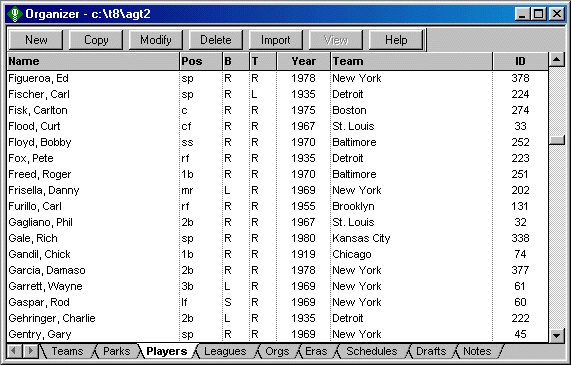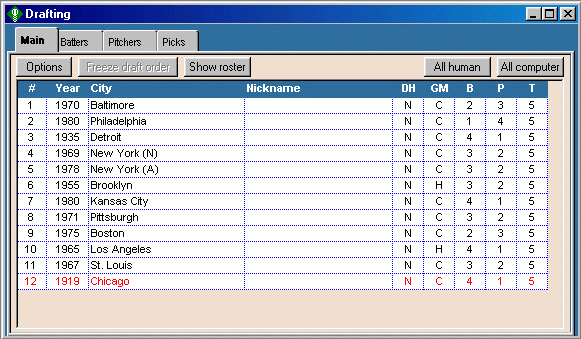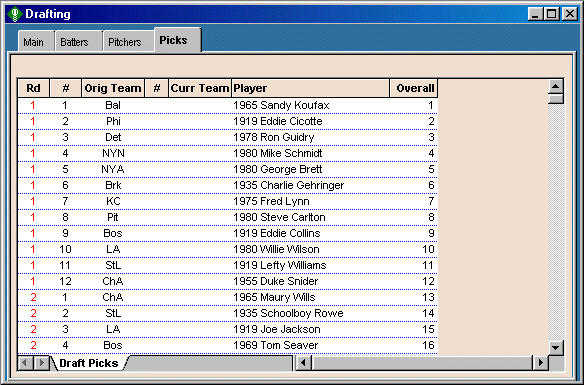About The Game
Transferring Statistics
Stats Collection Is Easy With DMB
If you are a member of a Diamond Mind Baseball league in which games are played on more than one computer, you can use the stats transfer functions to consolidate the results of those games on one computer and periodically issue updates that can easily be installed on the various computers used in the league.
NOTE: Please be sure you are not using these features to illegally distribute copies of our season disks. Each member of a league who is going to be playing games on his/her own computer must own a copy of the game and the season disk being used for the league. It is a violation of copyright law to send a DMB database to a league member who does not own a copy of the season disk upon which the league is based.
Here's how the process works:
- while setting up the league, the commissioner chooses league options that (if activated) will automatically generate a boxscore, scoresheet and game account file after each game, so league managers don't have to remember to save these items manually.
- the commissioner chooses a menu command that automatically zips up all of the files in the league database and creates a single transfer file that is ready to be sent (usually as an email attachment) to league members.
- each manager uses another menu command to install the updated league database. Neither the commissioner nor the league managers need to own a copy of PKZIP or any other tool of that sort, as the capability is built in.
- managers can generate reports, move players between the active roster and the reserve rosters, update their manager profiles, and play games using the update season totals.
- after playing games, making roster moves, or modifying his manager profile, the manager chooses a menu command that leads him through a simple three-step process to select the games, manager profiles and transactions to export. DMB keeps track of which games and transactions were already there at the beginning of the play cycle and automatically selects the ones that have been added since. (You can override these selections if you ever need to send something to the commissioner a second time.) When the selections are complete, a single transfer file is ready to be sent to the commissioner.
- to import these changes, the commissioner chooses a menu command that leads him through another simple three-step process to select the games, manager profiles and transactions to import. When the selections are complete, the file is imported, and DMB updates the schedule, year-to-date statistics, injury logs and anything else that is affected, after validating the file to ensure that the same information is not imported more than once.
- after the imports have been completed, the commissioner can choose another menu command that rebuilds the usage and streaks information. Now that all of the games are in one place and can be evaluated in the proper sequence, DMB goes through the game-by-game logs and figure hitting streaks and fatigue information correctly.
- Tags: Collection Export help file Import Stats
Player Profiles
Working With Player Profiles
When you're playing a game, choosing lineups, thinking about making roster moves, setting up a manager profile, or participating in a draft, you often want to know more about the players you're working with. How does he do against left-handed pitching? How many positions is he rated at and what are those ratings? Is he healthy right now? How many pitches did he throw yesterday?
That's why we give you access to the player profile window from most places in the product where player names are displayed.

The batting tab provides two blocks of batting stats (on tabs labelled primary and secondary), full left/right splits, and a summary of the player's most important ratings.
The pitching tab shows five blocks of pitching stats, plus full left/right splits, and key pitching ratings.
The fielding tab provides a full set of fielding statistics broken down by position.
The status tab summarizes fatigue information (pitches thrown in the past five days, batters faced as a catcher over the past ten days), injury status, and other usage information.
And the starts tab shows how often each player was in the starting lineup at each defensive position against left- and right-handed pitchers.
This information provides a very complete picture of each player, but we know that sometimes you wish to look at more than one player at a time. That's why the player profile window has a list of players in the upper left corner with two arrow buttons that allow you to cycle through a relevant group of players. If you've called up the profile window from a team roster, that group includes the players on the team. If you've called up the profile window from the game window, that group may consist of the current batting order for the team. Call it up from a list of free agents and it includes all of those free agents.
For players who appeared on more than one team in your DMB season, the 'Show combined stats' checkbox allows you to toggle between showing that player's stats for one team and his combined stats for all teams that he played for.
Finally, to the right of that checkbox is a drop-down list of the stages of the season. If you're in the midst of a post-season series, you can choose to look back at this player's performance during any previous stage of the season (the regular season or a previous playoff series).
- Tags: About The Game
Organizing Leagues and Teams
Using the Organizer
The Organizer window enables you to quickly find and work with any item in your active database. Click on the tabs at the bottom to display lists that show important information about the teams, parks, players, leagues and other contents of your database. On the player list, for example, you can see each player's position, batting and throwing hand, and his current team affiliation or free agent status.

The toolbar buttons provide access to the tools you need to create, copy, modify, delete and import any of these items, giving you the flexibility to create just about any type of league you want. You can do this using teams, players, parks and eras that you create yourself or import from different Diamond Mind season disks.
You can organize teams into leagues of up to four divisions of 16 teams each, and you have the option to create an organization that combines two leagues for inter-league and/or post-season play.
And, if you're running a league that uses Diamond Mind Baseball, you can organize notes (with bylaws, newsletters, or anything else you want) that will be distributed among members of your league using the new league management tools.
- Tags: About The Game
Roster Management
Managing Your Roster
As you move through your season, you can use the roster management and manager profile window to send players to the farm and call them up, move them on and off the disabled list, release players, sign free agents, and make other moves.
The roster window uses color to distinguish the players who are on the active roster, the reserve roster and the disabled list. To make a move, simply right-click on the name of the player, then choose from the commands on the popup menu that appears.

The other tabs make it easy for you to set up the manager profile that guides the computer manager in games that you do not play yourself. Using these tabs, you can set your starting rotation, relief roles, starting lineups versus left- and right-handed pitchers, platoons, defensive replacements, utility roles, manager tendencies, and player-specific tendencies. These can be updated at any time during the season.
Selected DMB seasons come with every real-life roster move and an option to play or autoplay those seasons using the actual game-by-game starting lineups and day-to-day rosters. When you use one of these seasons, and when you choose the option (one of the settings for a league) to use the real-life transactions, the status of each player changes automatically as you move through the season.
- Tags: About The Game
Diamond Mind Draft Module
Human and Computer Drafting
Computer drafting is an important capability, but there's a lot more to the new drafting system than just that. We've created a drafting environment that allows you to:
- draft new rosters from scratch or start with partially complete rosters (such as a group of players carried over from a previous season)
- save a draft in progress and resume it later
- browse lists of free agent batters and pitchers that show a full set of statistics and ratings, sort those lists on any statistic or rating, and filter those lists based on batting and throwing hand, position, playing time and more
- add supplemental draft picks for one or more teams in any round, or delete any draft pick (to punish teams for breaking league rules, for example)
- trade draft picks
- reverse a draft pick that was made in error
- void draft picks that a team is no longer eligible to make -- because it lost the right to that pick due a rules violation, because its roster is full, or for any other reason -- and reinstate previously voided picks
- ask the computer to make one or more picks automatically
- generate a report showing all of the picks that have been made in a draft
Before we get into a more detailed description of the drafting process, it's worth noting that you can sign free agents individually without setting up a formal draft, simply by choosing the 'Sign' command from the roster window. But if you want to set up a formal draft, here's how you go about it.
First, create a draft, specifying the league or leagues that are to participate, how many rounds you want it to last, and whether the teams draft in the same order each round (1, 2, 3, ... 1, 2, 3, ...) or in reverse order every other round (1, 2, 3, ... 3, 2, 1, 1, 2, 3, ...).
When you do this, DMB generates the full list of picks that will be made in the draft (the players to be picked aren't yet known, of course). At this point, you can delete picks, add supplemental picks, and trade picks. If you change your mind about the number of rounds, you can add or delete rounds as well. You can designate which teams will use a human general manager to make its picks and which teams will have the computer GM make the decisions. And you can manually change the order in which the teams will draft or ask to have a random draft order selected for you.

Figure 1. Draft control panel (after five rounds)
The draft control panel (see Figure 1) shows the draft order, whether each team needs to draft a designated hitter, whether the team has a Human or Computer general manager to make the picks, and the number of batters, pitchers and total players on each team's roster. The team due to pick next is highlighted.
Once you're happy with these things, you can freeze the draft order and get ready to start choosing players. At this point, you can still add, delete and trade picks (though you cannot delete or trade a pick that has already been made) to reflect events that occur during the draft.

Figure 2. List of free agent batters.
A human general manager selects a player from the lists of free agent batters and pitchers. These lists use our new reporting system to provide a powerful sorting and filtering capability that makes it easy to focus your search on the types of players you're most interested in. Figure 2 shows a list of the free agent batters with at least 300 plate appearances, sorted by slugging percentage. In short, there's a ton of data at your fingertips to help you make your decisions.
But you can also invoke the computer drafting feature to make one pick, make all picks up until the next team that has a human GM, make all picks through the end of a round, or make all picks through the end of the draft. As each pick is made, the name of the player is immediately added to the draft pick report, allowing you to follow along.
When evaluating the available free agents, the computer GM looks at the needs of the team to make sure that it fills all of the roles (starting pitchers, relievers, players rated at each defensive position, and so on). And it looks at the ability of each player to help the team win in ways that go beyond hitting and pitching to include things like defense (range, error rates, throwing, holding runners), speed and bunting.
All hitters and pitchers are judged on a park- and league-neutral basis so the true ability of the player comes through. This is appropriate because Diamond Mind Baseball makes these adjustments when you play the games, and it doesn't make sense to ignore them when choosing talent in the first place.
If, for instance, a pitcher was effective despite facing the DH and/or playing in a hitters' park in real life, he may well be chosen higher in the draft than someone whose stats look better but who had a more favorable real-life environment in which to do his work.
And you might see a slugging first baseman drop lower in the draft that you might expect. Why? Because first basemen are expected to produce more offense than players at other positions, so it's harder to stand out, and because some first basemen don't supply other things -- defense, speed, bunting, the ability to play more than one position -- that make a player more valuable to a team.
We believe we have come up with a pretty comprehensive way to evaluate the overall contribution that these players make to a team, and for that reason, we think the computer GM will provide a worthy companion in your drafts, whether you're trying to out-think it or whether you're asking for its help in choosing players for your team.

Figure 3. Draft pick report.
As each pick is made by the computer manager, it also generates a new manager profile that includes this player. That way, when you view the roster for this team (which you can do at any time during or after the draft), the manager profile is already there to give you an idea of what role the computer has assigned to each player on the roster.
As part of our work on the drafting system, we've also overhauled the manager profile generator. Those of you who have played previous version of Diamond Mind Baseball know that the manager profile generator was designed to match real-life playing time as closely as possible. This doesn't make as much sense for newly-drafted rosters, since you may draft a player who played more than one position with the idea of using him in a different way than he was used in real life. The new manager profile generator looks at the talent on your roster, considers a variety of ways those players can be combined, and chooses the arrangement that produces the best chance to win.
As with any system that attempts to emulate the process that human GMs go through in something as complex as building a baseball team, there's more we can do in the future to make the computer GM even more sophisticated. At present, it has no way to know which players are considered to be future stars despite mediocre-to-awful stats in the current season. Some way to assess future value is one of several ideas that are on our list of future enhancements, but even without these improvements, we think the current version will give you a run for your money.
- Tags: About The Game